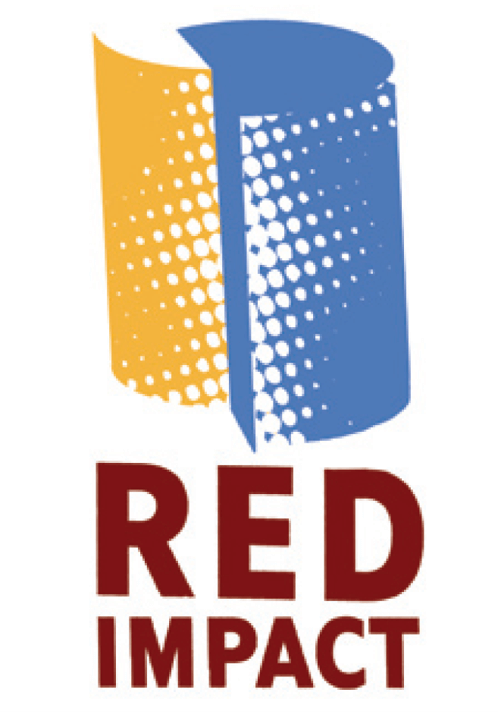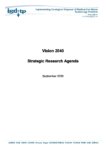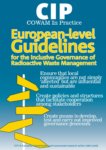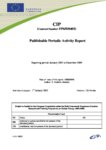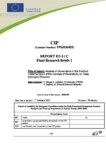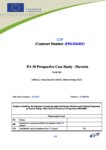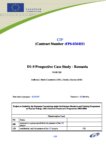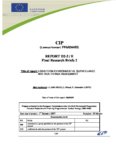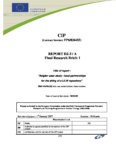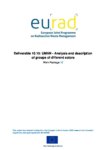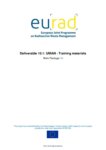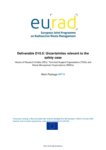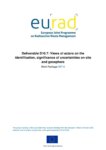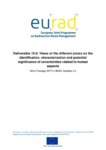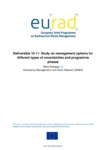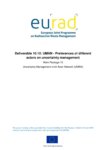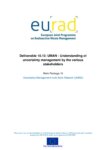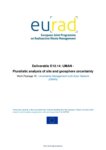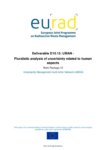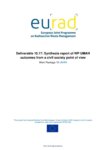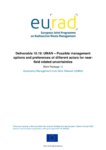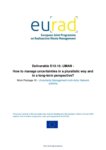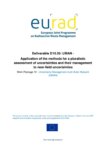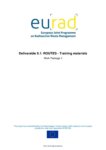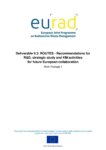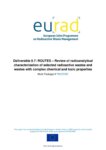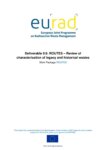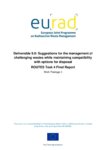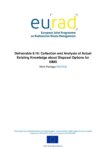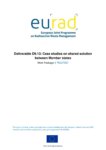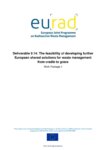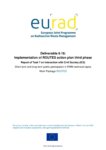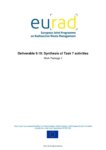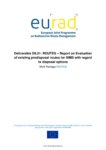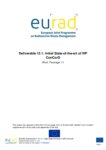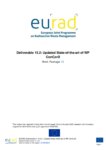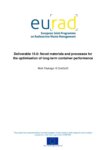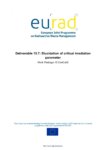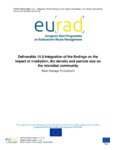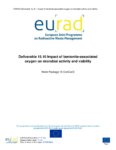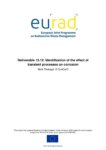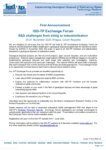Key Topic 8: Strategy for Repository Project Development
This research area concerns issues surrounding the movement from a disposal concept, to an established project, through to facility siting and operation, both in national and multi-national projects.
Overview
This research area involves RD&D and networking activities that contribute to the 2040 Vision second pillar, “Optimise and Industrialise”, and/or the third pillar, “Tailor Solutions”. More specifically, the research area covers how to move from a disposal concept, to an established project, through to facility siting and operation, both in national and multi-national projects. Although the steps are almost identical in both cases, the multi-national dimension adds further complications.
Objective
The objectives are to:
- identify the various aspects of the transitions from one project step to another;
- identify the decision-making processes for each project step;
- identify the underpinning knowledge and technologies needed in each step; and
- additionally, consider the above objectives from the viewpoint of shared (multi-national) solutions.
Establishment of the strategies and procedures for transitions between project steps at an early stage accelerates the decision-making process and helps to avoid mistakes. It also benefits the decision-making process if consistency across WMOs in the steps and procedures applied is achieved.
The transition from surface-based site characterisation for the site selection process to exploring the sub-surface at the selected site is complex and, depending on the regulatory framework, may require a separate licensing step. It does require a major shift in planning to include subsurface exploration, monitoring (see Key Topic 6) and performance confirmation, and it requires specifying aspects of the design of the future repository. One possible strategic
decision during the course of repository planning is retrievability/reversibility (e.g. whether it is a national requirement and how long reversibility should be possible for). Another consideration is that of facility security and international safeguards requirements, both technical and political (the latter aspect is being considered by the IGSC). Also, during the different stages of the project, cost estimation is an important part of project management and
needs to take into account the long durations and complex nature of geological disposal projects.
The current development of repository systems addresses mostly the disposal of power reactor spent fuel and/or HLW rather than spent research reactor fuel (SRRF), which is relevant to some small inventory member states (SIMS) programmes. For SIMS, the small quantities of SRRF are particularly difficult to manage and disposal options need to be developed. One disposal option, for small inventories and specific types of waste, could be Deep Borehole Disposal (DBD).
About half of the EU Member States are considering shared RWM disposal solutions. A core issue with shared RWM solutions is how to move from one project step to another. Using one or more practical case studies it can be shown how participating Member States can work together to establish how a route can be found through these steps. Progress of the EURAD ROUTES Work Package, including the recently proposed second wave extension to the project which addresses some issues relevant to SIMS, will be followed carefully to avoid duplicate work.
Related Documents
IGD-TP Vision 2040 and Strategic Research Agenda
Description: IGD-TP Vision 2040 and Strategic Research Agenda, published September 2020 (reference error corrected on 26/09/2022)
Last updated: October 7, 2020
2019 IGD-TP position letter regarding the call EC NFRP-10
Description: 2019 IGD-TP position letter regarding the call EC NFRP-10: Developing pre-disposal activities identified in the scope of the European Joint Programme in Radioactive Waste Management
Last updated: April 8, 2019
Description: The booklet: "COWAM In Practice - European level Guidelines for the Inclusive Governance of Radioactive Waste Management". Providing the principal messages and ideas from the COWAM In Practice (CIP) project delivered to the EU for the governance of RWM.
Last updated: January 12, 2022
COWAM In Practice – Publishable Periodic Activity Report 2007-2009
Description: Periodic activity report of the COWAM In Practice project, reporting period January 2007 to December 2009.
Last updated: January 12, 2022
Description: Report D2-3/C (Final Research Briefs 1) of the COWAM In Practice project. Titled "Aspects of Governance in the Practical Implementation of the Concept of Reversibility for Deep Geological Disposal"
Last updated: January 12, 2022
COWAM In Practice – First annual activity summary
Description: First annual activity summary of the COWAM In Practice project.
Last updated: January 12, 2022
COWAM In Practice – Compte-rendu des activités du groupe CIP France “French Prospective Case Study”
Description: COWAM In Practice - Compte-rendu des activités du groupe CIP France “French Prospective Case Study”
Last updated: January 12, 2022
COWAM In Practice – Prospective Case Study: Slovenia
Description: COWAM In Practice report D1-10 - Country Reports on the Cooperative Investigation: Slovenia.
Last updated: January 12, 2022
COWAM In Practice – Sustainable Territorial Development Associated with Radioactive Waste Management
Description: COWAM In Practice report D2-5/A (Final Research Briefs 2) "Sustainable Territorial Development Associated with Radioactive waste management".
Last updated: January 12, 2022
COWAM In Practice – Prospective Case Study: Romania
Description: COWAM In Practice report D1-9 - Country Reports on the Cooperative Investigation: Romania.
Last updated: January 12, 2022
COWAM In Practice – Long-Term Environmental Surveillance and Health Risk Assessment
Description: COWAM In Practice report D2-5/E - "Long-Term Environmental Surveillance and Health Risk Assessment"
Last updated: January 12, 2022
COWAM In Practice – Belgian case study: local partnerships for the siting of a LILW repository
Description: COWAM In Practice report D2-3A "Belgian case study: local partnerships for the siting of a LILW repository"
Last updated: January 12, 2022
COWAM 2 – Roadmap for Local Committee Construction
Description: Output of COWAM 2 WP1 - "Roadmap for Local Committee Construction"
Last updated: January 12, 2022
EURAD/UMAN D10.10: UMAN – Analysis and description of groups of different actors
Description: EURAD/UMAN Deliverable 10.10: "UMAN - Analysis and description of groups of different actors".
Last updated: June 17, 2022
Description: The main purpose of this guide was to provide information on the cost estimation in relation to the establishment, development, implementation and improvement of a waste disposal programme and to provide insight into the implementation of a financial scheme that ensures the efficient and sustainable financing of the programme.
Last updated: June 17, 2022
UMAN Deliverable 10.1: Training materials
Description: This report contains the aims, the learning outcomes and the description of the training course organised by the Work Package UMAN on February 14-16 2023 at Bel V (Brussels, Belgium). The report also contains abstracts of the lectures, the slides prepared and presented by each lecture, a career summary of these lecturers and the test organised at the end of the training course.
Last updated: February 13, 2025
UMAN Deliverable 10.2: Generic strategies for managing uncertainties
Description: This report presents the findings of Sub-Task 2.1 of the UMAN work package of EURAD project. UMAN is focused on developing a common understanding among European Waste Management Organisations (WMOs), Technical Support Organisations (TSOs) and Research Entities (REs) and civil society of strategies and approaches for managing uncertainties by sharing knowledge and identifying remaining and emerging issues. Sub-Task 2.1 is focused specifically on identifying generic strategies for managing uncertainties. The Sub-Task 2.1 work has largely drawn on responses from WMOs, TSOs and REs to a questionnaire produced for the UMAN project to facilitate information gathering.
Last updated: February 13, 2025
UMAN Deliverable 10.3: Uncertainty identification, classification and quantification
Description: This deliverable is specifically related to Subtask 2.2 “Uncertainty identification, classification and quantification”, which deals with approaches to identify and classify uncertainties that might be of relevance in the various stages of radioactive waste management as well as on the quantification of numerical uncertainties.
Last updated: February 13, 2025
UMAN Deliverable 10.4: Methodological Approaches to Uncertainty and Sensitivity Analysis
Description: This report presents the findings of the EC UMAN project regarding to methodological approaches used in the uncertainty and sensitivity analysis. The work also includes examples of the application of different methods to existing sets of probabilistic PA calculations. The major input to this report comes from a dedicated UMAN questionnaire.
Last updated: February 13, 2025
UMAN Deliverable 10.5: Uncertainties relevant to the safety case
Description: This report assesses the views of different actors, principally of waste management organisations, technical safety organisations and research entities on the uncertainties in a safety analysis and in a safety case for geological disposal of radioactive waste and how the uncertainties may evolve over time.
Last updated: February 13, 2025
Description: This UMAN WP deliverable D 10.6 presents the views of the different actors on the identification, characterization and potential significance of uncertainties related to waste inventory. Information contained in this deliverable provides input to the work performed in Subtask 4.2 on possible uncertainty management options, as well as to Task 5 dedicated to interactions within a broader group of actors including civil society.
Last updated: February 13, 2025
Description: Compilation of views of actors on the identification, significance of uncertainties on site and geosphere
Last updated: February 13, 2025
Description: The report presents the description of the human-related uncertainties, synthetizing the results from the various inputs with a focus on the ten main uncertainties associated with the following topics and considered as of high-priority for further investigation, i.e.: • A: Process for the identification of a workable set of repository requirements • B: Continuity of the waste management policy along political changes • C: Robustness of the presently considered safety requirements with regard to the long term • D: Public acceptance of the repository at potentially suitable or projected location • E: Schedule to be considered for implementing the different phases of the disposal programme • F: Robustness of the safety case vis-à-vis sociotechnical factors • G: New knowledge • H: Adequacy of safety-related activities (in siting, design, construction, operation and closure) for the implementation of (operational and long-term) safety provisions • I: Robustness of safety vis-à-vis possible cyber-attacks or programming errors • J: Availability of well-educated human resources, and relevant experts in radioactive waste management along the repository lifetime until closure
Last updated: February 13, 2025
Description: This EURAD deliverable 10.9 focuses primarily on the analysis of uncertainties significance from the point of view of the three categories of actors (WMOs, TSOs and REs).
Last updated: February 13, 2025
Description: This report focusses on providing a comprehensive overview about different approaches and uncertainty management options to assess and, where is possible and relevant, to reduce risks and optimise safety.
Last updated: February 13, 2025
UMAN Deliverable 10.12: Preferences of different actors on uncertainty management
Description: This report synthetises the four UMAN workshops which focused on the views of the actor’s groups on safety significance of the topical uncertainties and its evolution over the programme phases, preferred uncertainty management options and strategies, potential future joint activities and initiatives, including research and development, strategic studies and knowledge management.
Last updated: February 13, 2025
UMAN Deliverable 10.13: Understanding of uncertainty management by the various stakeholders
Description: This report provides information about the work carried out in UMAN Task n°5 - Interactions between all categories of actors, including Civil Society in the frame of Subtask 5. 1 – Preparation, support and reporting of pluralistic analyses, topic 1: Meaning for different actors of uncertainty management and of its relationships with risk, safety and the safety case. Various inputs were used for Topic 1 but the central instrument was a seminar held on 26-27 October 2020 (“UMAN seminar 1. What does uncertainty management mean for different types of actors and how is it related to risk, safety and the safety case?”). The report provides a description and interpretation of the seminar.
Last updated: February 13, 2025
UMAN Deliverable 10.14: Pluralistic analysis of site and geosphere uncertainty
Description: This report provides information about the work carried out in UMAN Task n°5 - Interactions between all categories of actors, including Civil Society in the frame of Subtask 5. 1 – Preparation, support and reporting of pluralistic analyses. Initially, it was planned to organize discussions of Seminar 2 on Topic 2 (uncertainty pictures at different steps of geological disposal programme) and Seminar 3 on Topic 3 (uncertainty management options for addressing uncertainties throughout a disposal programme). As it is a continuous process, Task 5 adapted the initial planned to take into account the results of seminar 1.
Last updated: February 13, 2025
UMAN Deliverable 10.15: Pluralistic analysis of uncertainty related to human aspects
Description: This deliverable provides information about the work carried out in UMAN Task n°5 - Interactions between all categories of actors, including civil society in the frame of Subtask 5. 1 – Preparation, support and reporting of pluralistic analyses. Task 5 adapted the initial work plan and focused in seminar 3 on human related uncertainties. In this seminar, actors’ views on these uncertainties and the management options for the most safety significant uncertainties were discussed together.
Last updated: February 13, 2025
UMAN Deliverable 10.17: Synthesis report of WP UMAN outcomes from a civil society point of view
Description: This report provides a synthesis of the work carried in UMAN Subtask 5.2 – Input of civil society experts – in the frame of UMAN Task n°5 – Interactions between all categories of actors, and its main outcomes from a civil society point of view. The views of civil society on WP UMAN results were collected and developed in depth through five seminars.
Last updated: February 13, 2025
Description: This deliverable analyses the views of the three categories of actors collected via the new UMAN Questionnaire on near-field uncertainties, launched on April 5, 2022. It includes also the results of Task 3.6 Workshop held at RATEN, Romania 24-25 November 2022, where the replies to the questionnaire and the SotAs of CONCORD and MAGIC have been presented and discussed. In addition, discussion within Seminar 5 (at BelV, Brussels 06-07 December 2023) were taken into account, where CS representatives joint the discussion on near-field uncertainties with WMOs TSOs and REs.
Last updated: February 13, 2025
Description: This report presents the aspects of management of near-field uncertainties as investigated in Subtask 4.2 as well as in the 5th Workshop of Subtask 4.3.
Last updated: February 13, 2025
Description: This report provides information about the work carried out in UMAN Task n°5 - Interactions between all categories of actors, including civil society in the frame of Subtask 5. 1 – Preparation, support and reporting of pluralistic analyses, topic 4: Methods that can be used for discussing and organizing pluralistic assessments of uncertainties with civil society stakeholders throughout a disposal programme. Various inputs were used for topic 4, but the central instrument was a seminar held on 14-15 December 2022 (“UMAN seminar 4. How to manage uncertainties in a pluralistic way and in a long-term perspective?”). This report provides a description and interpretation of the seminar.
Last updated: February 13, 2025
Description: This report provides information about the work carried out in UMAN Task n°5 - Interactions between all categories of actors, including Civil Society in the frame of the extension of Subtask 5.1 – Preparation, support and reporting of pluralistic analyses. Existing Task 5 have been extended to test with a broader stakeholder group including civil society the methods identified by UMAN Task 5 (and more especially during UMAN Seminar 4) for a pluralistic assessment of uncertainties and their management, using near-field uncertainties as case study.
Last updated: February 13, 2025
ROUTES Deliverable 9-1: Training materials
Description: Training material from a EURAD (European Joint Programme on Radioactive Waste Management) and PREDIS (Pre-disposal management of radioactive waste) joint Summer School on Waste Acceptance Criteria (WAC) for radioactive waste. The training took place in September 4-8, 2023.
Last updated: February 13, 2025
Description: This report presents the identified Research and Development (R&D), Strategic Studies (StSt) and Knowledge Management (KM) needs and opportunities for collaboration between Member States, and details the recommendations as a result of the insights and achievements obtained from the deliverables and milestones generated in ROUTES tasks.
Last updated: February 13, 2025
ROUTES Deliverable 9-5: Overview of issues related to challenging wastes
Description: This deliverable presents the main outcomes of the ROUTES Subtask 2.2 meetings, detailing the major difficulties at stake for each challenging waste and initiatives that have been implemented by some Member States.
Last updated: February 13, 2025
Description: The objective of this deliverable is a comprehensive description of radioanalytical characterisation, including • the identification of characterisation techniques, • the comparison of characterisation methods applied for the same waste in different countries, • the analysis of existing approaches and identification of knowledge gaps, as well as • to give recommendations both for future research and development (R&D) tackling the identified knowledge gaps and for characterisation approaches for countries with non-developed waste management concepts.
Last updated: February 13, 2025
ROUTES Deliverable 9-8: Review of characterisation of legacy and historical wastes
Description: The aim of Task 3 of ROUTES is to identify techniques for characterisation, to compare the methods applied in different countries, to identify knowledge gaps and give recommendations for future R&D. This report summarises the results gained in work on the second subtask of Task 3 on characterisation and segregation of legacy waste.
Last updated: February 13, 2025
Description: The present report is the sole deliverable documenting the work performed under ROUTES Task 4. It summarises the outcomes of ROUTES Subtasks 4.1, 4.2 and 4.3, namely: • Current use of WAC in Member States and some Associated Countries. • Key discussion points from the Subtask 4.2 workshop titled “Sharing experience on waste management with / without WAC available” held on 14-15 June 2021. • The results of a gap analysis performed following the workshop including a series of observations and recommendations aimed at supporting the progression of waste management activities when uncertainties remain regarding future stages in the waste lifecycle, particularly disposal end points, and/or when associated WAC are absent. • Key discussion points from the Subtask 4.3 workshop titled “R&D needs and opportunities for collaboration” held on 10 May 2022. • The process for identifying, screening and prioritising commonly held WAC-related R&D needs and the opportunities for potential future collaboration between Member States and Associated Countries on this topic.
Last updated: February 13, 2025
Description: The aim of this report is to compile the existing knowledge on the various options for the final disposal of radioactive waste that could be used for small amounts of waste.
Last updated: February 13, 2025
Description: This second deliverable of Task 5 focuses on the necessary predisposal routes including pre-treatment, treatment and conditioning of RAW for the disposal options for SIMS. The aim of this report is to compile the existing knowledge, shared during the workshop in January 2022 (month 32 of EURAD) of this subtask.
Last updated: February 13, 2025
ROUTES Deliverable 9-13: Case studies on shared solution between Member states
Description: This deliverable gathers case studies on shared solutions between Member States in different stages of the waste lifecycle. In this document, shared solutions are defined as knowledge sharing and the sharing of facilities/technologies.
Last updated: February 13, 2025
Description: This report identifies promising topics and waste streams that could lead to opportunities for collaborative solutions between member states.
Last updated: February 13, 2025
Description: In this deliverable the results of the investigations are provided, including comments, suggestions, questions, and other observations collected in interaction with EURAD participants and the Civil Society larger group.
Last updated: February 13, 2025
Description: Implementation of ROUTES action plan third phase; Report of Task 7 on Interaction with Civil Society (ICS); Short term and long-term public participation in RWM technical topics
Last updated: February 13, 2025
ROUTES Deliverable 9-19: Synthesis of Task 7 activities
Description: Deliverable 9.19 “Synthesis report of Task 7 activities” aims to provide summary of the ROUTES Task 7 activities on interaction with Civil Society.
Last updated: February 13, 2025
Description: This report includes the results of Subtask 8.1, which aims at assessing the existing predisposal routes for SIMS based on the input of two workshops held in January 2022 (M30) and May 2022 (M34).
Last updated: February 13, 2025
Description: Summary report on analysis, assessment and evaluation of disposal options for SIMS (taking into account both potential disposal options and predisposal routes) including Annex: Case studies on typical waste pathways.
Last updated: February 13, 2025
CONCORD Deliverable 15-1: Initial State-of-the-art of WP ConCorD
Description: This report provides a review of the current state of the knowledge on the corrosion behaviour of candidate container materials for the disposal of spent fuels (SF) and high-level radioactive waste (HLW).
Last updated: February 14, 2025
CONCORD Deliverable 15-2: Updated State-of-the-art of WP ConCorD
Description: In this report the different aspects concerning the degradation of nuclear waste containers and the technological approaches for a better performance are summarized.
Last updated: February 14, 2025
CONCORD Deliverable 15-3: Training materials
Description: This report provides an overview of presentations that can be used as training materials related to the ConCorD WP.
Last updated: February 14, 2025
CONCORD Deliverable 15-4: Updated Training materials
Description: The outline and learning outcomes for each of the topics of the ConCorD training course is given in this report.
Last updated: February 14, 2025
Description: Novel materials and processes for the optimisation of long-term container performance
Last updated: February 14, 2025
CONCORD Deliverable 15-7: Elucidation of critical irradiation parameter
Description: This document is deliverable 15.7 of the EURAD WP15 ConCorD and aims to elucidate the critical parameters associated with radiation exposure when considering the corrosion performance of candidate canister materials for deep geological disposal of radioactive waste.
Last updated: February 14, 2025
CONCORD Deliverable 15-8: Synthesis of irradiation results under repository conditions
Description: The objective of the present report was the assessment of irradiation-accelerated corrosion of canister materials in realistic environments and irradiation conditions.
Last updated: February 14, 2025
Description: Integration of the findings on the impact of irradiation, dry density and particle size on the microbial community
Last updated: February 14, 2025
Description: In this report, the results of a 1.5-year-long borehole incubation experiment aimed at evaluating the persistence of oxygen in bentonite under anoxic conditions are presented.
Last updated: February 14, 2025
CONCORD Deliverable 15-12: Identification of the effect of transient processes on corrosion
Description: This document is deliverable 15.12 of the EURAD WP15 ConCorD and gathers the experimental studies carried out within Task 5, aimed to identify the role of transient conditions on corrosion of materials selected for disposal canisters in deep geological repositories for high-level radioactive waste.
Last updated: February 14, 2025
CONCORD Deliverable 15-14: ConCorD Synthesis Report
Description: The aim of the this synthesis report was to draw together a summary of the work carried out in the various tasks of the project and to identify the key aspects and outcomes that may be applied in the preparation of future performance assessments and safety cases by the national waste management organisations.
Last updated: February 14, 2025
IGD-TP Exchange Forum 2025 – First Announcement
Description: IGD-TP Exchange Forum 2025 - First Announcement (issued 14 March 2025, revised 13 April 2025)
Last updated: March 14, 2025
IGD-TP Exchange Forum 2025 – Second Announcement and Call for Posters
Description: IGD-TP Exchange Forum 2025 - Second Announcement and Call for Posters (issued 2 June 2025)
Last updated: June 2, 2025
Related Activities
CARD
